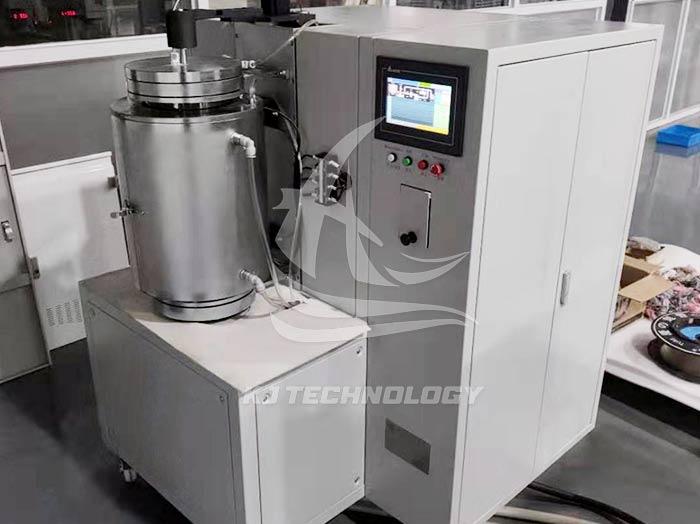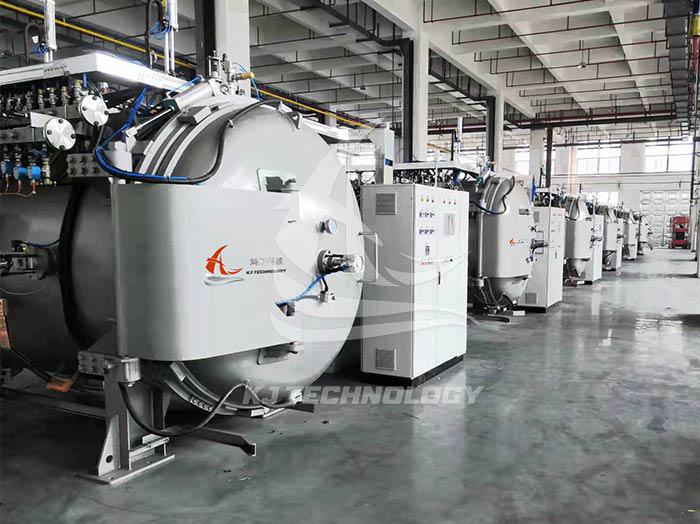Application of High Vacuum Furnace in the New Materials Industry
 07-25-2025 Author: KJ technology
07-25-2025 Author: KJ technology
High vacuum furnaces are widely used in the new materials industry. By creating a high vacuum environment, they effectively avoid oxidation and pollution of materials during high-temperature processing, providing key technical support for the research and production of new materials. The specific application scenarios and advantages are as follows:
1. Core application scenarios
Preparation of nanomaterials
Technical principle: Under high vacuum environment (10 ⁻²~10 ⁻³ Pa), metal vapor oxidation is controlled by evaporation condensation mechanism, combined with high temperature evaporation and rapid condensation at 800~1500 ℃, to form uniformly sized nanoparticles.
Typical case: Vacuum thermal reduction preparation of graphene supported metal catalysts, which can synthesize metal powders such as nanosilver and nickel, as well as ceramic powders such as Al ₂ O3 and SiC. The particle size distribution can be controlled below 50 nm to avoid oxidation impurities and improve material properties.
Growth of Third Generation Semiconductor Materials
Technical principle: Under high temperature and vacuum environment above 1600 ℃, the growth process of silicon carbide (SiC) crystals can avoid carbon oxidation, promote the full reaction of silicon carbon elements, and form uniformly structured single crystals.
Typical case: By adjusting the gas atmosphere ratio, doping modification of wide bandgap materials such as gallium nitride (GaN) is achieved, optimizing their electrical properties to meet the demand for high-frequency and efficient materials in fields such as 5G communication and power electronics.
Research and development of new ceramics and composite materials
Technical principle: Under vacuum and N ₂ switching atmosphere (partial pressure 1-10 kPa), combined with high temperature and hot pressing process at 1600-2000 ℃, the sintering temperature is reduced, the decomposition of nitride ceramics (such as BN, Si ∝ N ₄) is suppressed, and the density (>95%) and dielectric properties are optimized.
Typical case: Silicon nitride ceramic bearing balls prepared by vacuum sintering, with a hardness of HRA92 or higher and a threefold increase in wear resistance, are widely used in electric drive systems for new energy vehicles.
High entropy alloys and melting of refractory metals
Technical principle: Using vacuum arc furnace or electron beam melting technology, single crystal ingots are prepared by evaporating impurities (such as reducing C and O content to below 10 ppm) at high temperatures above 3000 ℃ and under a maximum vacuum of 10 ⁻⁵ Pa.
Typical case: Vacuum melted tungsten molybdenum alloy, used to manufacture rocket nozzles and first wall materials for nuclear fusion devices, capable of withstanding extreme high temperatures and radiation environments.
2. Technological advantages and industry value
Improve material purity and performance
The vacuum environment can eliminate oxide layers and pollutants, achieving a surface smoothness of less than Ra0.1 μ m for nanomaterials, reducing friction losses, and improving equipment operating efficiency.
By precise temperature control (± 1 ℃) and uniform heating, the grain size can be refined to the micrometer level, significantly improving the strength, hardness, and toughness of the material. For example, vacuum treated silicon carbide fibers have a tensile strength of over 4.5 GPa and improved temperature resistance up to 1800 ℃.
Reduce production costs and energy consumption
Vacuum treatment can reduce the oxidation loss of metal materials, increase the yield by about 15%, and reduce subsequent cleaning and machining costs. For example, stainless steel bearings treated with vacuum annealing do not require sandblasting or shot blasting, and can directly enter the assembly process, reducing the production cycle by 30%.
The vacuum suspension melting technology uses electromagnetic induction heating, which reduces energy consumption by 40% compared to traditional melting, and is suitable for melting precious metals such as titanium alloys and high-temperature alloys.
Meet high-end manufacturing needs
In the aerospace field, vacuum treated nickel based high-temperature alloy components can withstand temperatures above 1500 ℃, meeting the extreme working conditions requirements of engines.
In the medical field, titanium alloy joint replacement parts processed by vacuum furnaces maintain cleanliness even at the microscopic level, significantly improve biocompatibility, and extend their service life to over 20 years.
3. Typical Case Analysis
Silicon carbide crystal growth
Application scenario: A semiconductor company uses a high vacuum furnace to grow 6-inch silicon carbide single crystals. By optimizing the vacuum degree (<10 ⁻⁴ Pa) and temperature gradient (10 ℃/cm), the crystal defect density is reduced to below 10 ³ cm ⁻ ², meeting the requirements of power devices for new energy vehicles.
Economic benefits: Shorten the growth cycle of single crystals by 20%, increase material utilization by 15%, and reduce costs by 30%.
Melting of high entropy alloys
Application scenario: A research team uses a vacuum arc furnace to melt FeCoNiCrMn high entropy alloy. By precisely controlling the vacuum degree (5 × 10 ⁻⁴ Pa) and melting times (5 times), significant improvements in composition uniformity (± 0.1 at.%) and mechanical properties (yield strength>1 GPa) are achieved.
Industry impact: This alloy has been applied to 3D printing of aircraft engine blades, replacing traditional nickel based alloys, reducing weight by 20% while improving temperature resistance.








